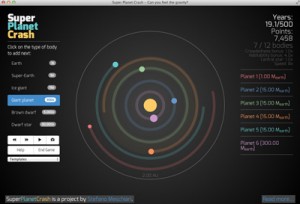Let the games begin!
A new online educational resource allows the user to build their own planetary system, putting planets into orbit around a star and racking up points until they add a planet that destabilizes the whole system.
The game is an offshoot of the open-source software package – Systemic Console — astronomers use to find planets beyond our solar system, called exoplanets.
NASA is a leading backer of ground and space-based telescope research in the on-going campaign to look for other worlds beyond our solar system.
The release of “Super Planet Crash” is a brain-buster idea, primarily masterminded by Greg Laughlin, professor and chair of astronomy and astrophysics at the University of California Santa Cruz and Stefano Meschiari, now a W. J. McDonald Postdoctoral astronomer at the University of Texas at Austin.
Most visceral level
“Systemic Console is open-source software that we’ve made available for other scientists to use. But we also wanted to create a portal for students and teachers so that anyone can use it,” Laughlin said.
“For the online version, Stefano tuned the software to make it more accessible, and then he went even further with Super Planet Crash,” Laughlin said, “which makes the ideas behind planetary systems accessible at the most visceral level,” according to a UC Santa Cruz press release.
The result?
It doesn’t take long for a player to understand the physics of orbital dynamics.
Meschiari said he is keen on simulating the evolution of protoplanetary disks, the characterization of extrasolar planets, as well as citizen science-driven projects.
Support for the development of the core scientific routines underlying the Systemic Console was provided by an National Science Foundation CAREER Award to Laughlin.
To play Super Planet Crash, go to:
By Leonard David

